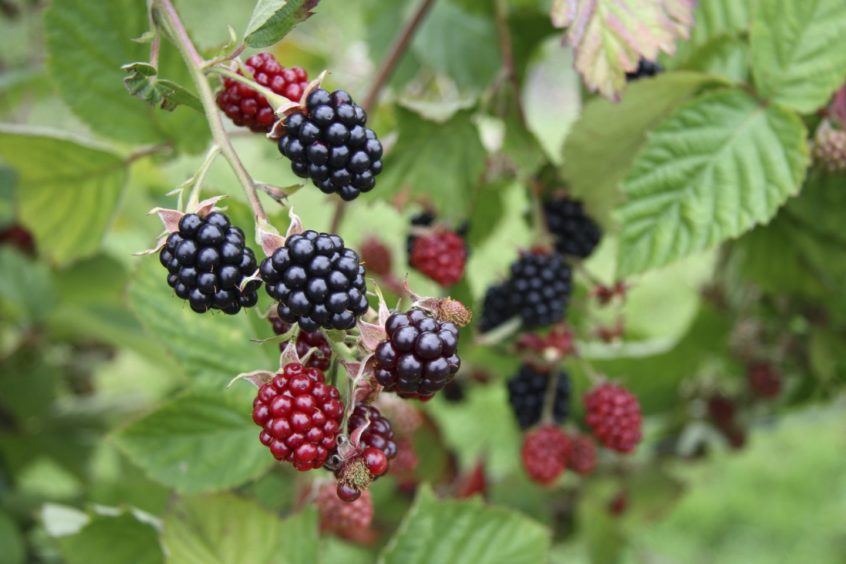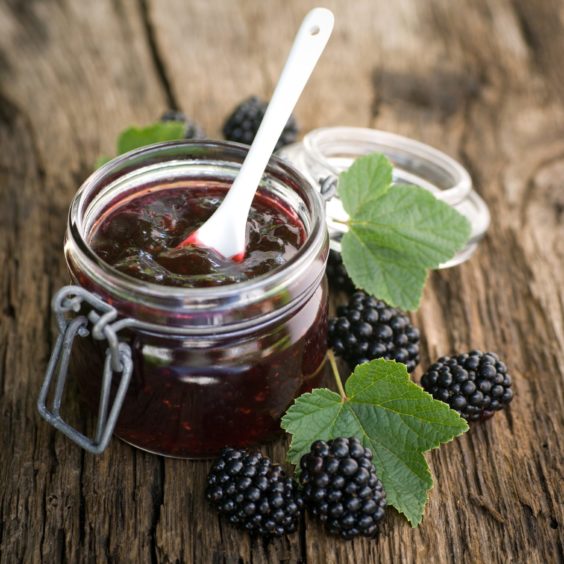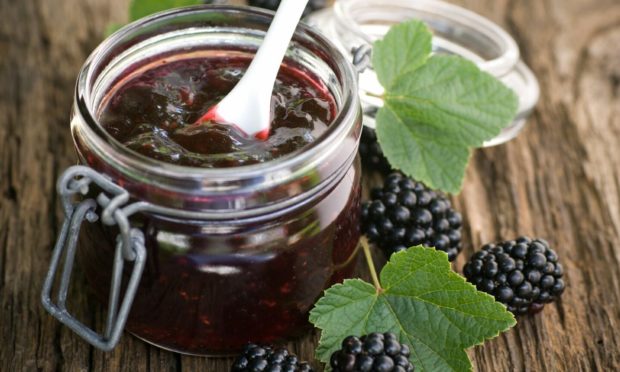A bramble jelly to be enjoyed throughout winter, and a handy bramble sauce from Claire Macdonald.
As I write this, the bramble season looks so promising that I find myself wishing away these wonderful days of late summer sunshine, which I am loving, and keeping a daily eye on the brambles around where we live.
They are obligingly turning from tight green little berries to red, with one or two black berries already visible.
I love brambling, I love eating brambles, and I love knowing that I have a stash of frozen brambles tucked away in our freezer, for use during the winter months.
Firstly, brambles freeze exceptionally well. I can only think of rhubarb which freezes as well as brambles – just pack the brambles into thick poly bags, seal, label and freeze.

I have come to the conclusion that cultivated brambles are a different species entirely to wild brambles, cultivated are pretty much tasteless. It follows that bought bramble foods, jam and jelly, are made from cultivated berries, so their flavour tastes disappointing by comparison.
However, lemon juice enhances the flavour of brambles and while you can’t actually taste the lemon, the flavour of the berries is so much more intense. But commercial jam makers don’t think of doing this, of adding lemon juice to their fruit. Homemade bramble jelly is one of life’s great treats.
You do need a year when brambles are plentiful to make any amount of jelly from them, because the yield of jelly is disproportionate to the amount of brambles. You can add apples, chopped, skin, core and all, but if you do, don’t add more than one or two apples. Their presence dilutes the taste.
Here are two recipes: the first, for bramble jelly, to be enjoyed throughout the winter months, on warm scones or toast or pancakes.
My second is for a really good sauce to be served with any poultry, ham, pork or game. It has the added benefit of being able to be made in advance by 24 hours without deteriorating in the slightest, just needing reheating to serve.
Bramble Jelly
Makes between 5 and 6 pots of 400g

Ingredients
- 2.5kg brambles
- Cold water, enough to cover the brambles
- 450g granulated sugar per 600ml bramble liquid (measured once the brambles have been cooled and sieved)
- 150ml lemon juice
Method
- Firstly, make sure that your pots are scrupulously clean. Remove the lids, and put the jars on a metal tray in a low-temperature oven to warm through.
- Warm a couple of extra jars over and above the number you anticipate needing.
- Put the brambles into a large pan. Add cold water to come level with the surface of the brambles. Simmer for 15-20 minutes, then take the pan off the heat and leave to cool.
- Next, get two large polythene jugs. Put a sieve over one, tip some of the contents of the cooled and cooked brambles and their liquid into the sieve.
- Before the jug is filled, lift the sieve on to the second jug and tip the rest of the contents of the pan into this.
- Leave for the juice to drip through the sieve – beware letting the base of the sieve touch the contents of the jug beneath.
- Very gently, using the base of a ladle, press the berries to extract as much liquid as possible, then discard the contents of the sieve.
- Add the lemon juice to the combined liquids, mix, then measure into a clean saucepan. I do 900ml plus 625g granulated sugar as I find it so much easier to make all jams and jellies, not just this bramble jelly, in relays.
- Put a large saucer or plate into the fridge to chill – this is for testing for a set.
- Put the first pan of juice and sugar on the heat and stir until the sugar has dissolved completely, only then allow the liquid to boil. Boil fast and furiously, stirring occasionally and watching all the time lest it over-boil and you have a horrible sticky burnt mess to clear up.
- The bubbles will be small and almost frothy initially but after about 15 minutes the bubbles slow down and suddenly become larger.
- Take the pan off the heat, take the chilled plate from the fridge and drip a small dribble of liquid from the pan on to the plate.
- Leave for several minutes to cool, then, with your finger, gently push the surface of the dribble.
- It will wrinkle as you push, if you have achieved a set. If it is completely liquid, put the pan back on the heat and bring back to a fast boil.
- From fast boiling, give it five more minutes before taking the pan off the heat and testing once again for a set.
- Carefully pour the liquid jelly into some of the warmed jam jars, cover each with a disc of paper, then, when cooled, with a larger disc of cellophane and its lid. Store in a cool place. Only label the jars once they are cold. Repeat, until you have used up all the bramble liquid.
Bramble and shallot sauce
Serves 6

Ingredients
- 3 large ‘banana’ shallots, each skinned, halved and finely diced
- 900ml good stock, either chicken stock or vegetable
- A small sprig of thyme
- 250g brambles
- 1 tbsp lemon juice
- 1 tbsp white wine vinegar
- 1 rounded tbsp granulated sugar
- 50g soft butter mixed very well with 2 just-rounded tsp plain flour
- ½ tsp salt
- 10 grinds of black pepper
Method
- Put the finely diced shallots into a saucepan together with the stock and sprig of thyme.
- Bring the stock to simmering point, cover with a lid and simmer very gently for 10-15 minutes, lid on. Add the brambles, and simmer for a further three to four minutes, without the lid on the pan.
- Put the granulated sugar into a small saucepan and, over heat, shake the pan – do not stir – as the sugar granules dissolve.
- When all are dissolved and you have a molten amber substance, cover your pan-holding hand with a cloth as you add the lemon juice and wine vinegar to the caramel in the pan. There will be a hiss of steam.
- Add some of the liquid from the shallots and brambles, and stir until the caramel has dissolved into the stock.
- Then tip this into the pan containing the shallots, brambles and stock.
- Mix some of this hot liquid into the flour and butter mixture, mixing well, then whisk this into the contents of the stock/shallots/brambles/melted caramel pan.
- Stir continuously till the sauce bubbles gently, thickened with the butter/flour combination.
- Add the salt and black pepper, taste, and add more if you think it is required.
- Cool, cover the pan, and reheat before serving.
